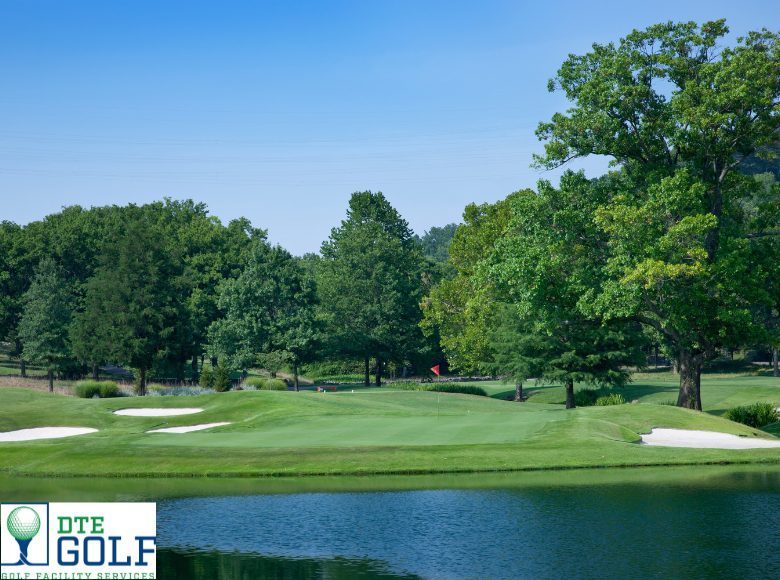A well-functioning golf course drainage system is essential for maintaining playability and turf health. Without proper drainage, excess water accumulates on the fairways and greens, making them unplayable. This leads to soggy conditions, increased turf diseases, and damage to the grass structure. Effective drainage prevents these issues by allowing water to flow away efficiently, keeping the turf firm and playable throughout the year.
Golf maintenance solutions are designed to prevent waterlogging by improving soil permeability and managing runoff. Using drainage pipes, sand-based topdressing, and aeration techniques, golf courses can ensure proper moisture control. Without these solutions, water remains stagnant, creating muddy areas that disrupt the game’s quality and increase maintenance costs.
Standing water can ruin course conditions and lead to costly repairs. DTE Golf® ensures proper drainage management to maintain optimal turf conditions.

Key Components of an Effective Golf Course Drainage System
Proper golf course maintenance involves installing and maintaining essential drainage components. These include surface drains, subsurface drains, and grading techniques that control water movement. Each component plays a role in directing excess water away from key playing areas.
- Surface Drains: These are designed to remove water from low-lying areas on the course, preventing puddles and surface erosion.
- Subsurface Drains: These underground pipes help move excess moisture out of the soil, preventing root saturation and maintaining firm turf conditions.
- Grading and Contouring: Sloping fairways and greens properly direct water away from play areas, ensuring smooth gameplay even after heavy rain.
Regular inspections and maintenance of these systems ensure that they function correctly throughout the year. By investing in golf maintenance solutions, golf courses can maintain high-quality playing conditions and reduce downtime caused by waterlogged turf.
Preventing Water Accumulation in High-Traffic Areas
High-traffic areas such as greens, tee boxes, and walkways require special attention to drainage. Frequent foot traffic and golf cart movement compact the soil, reducing its ability to absorb water. This results in pooling, making these areas unplayable.
To address this, aeration and topdressing with sand help improve soil structure, enhancing water infiltration. Additionally, installing drainage trenches in these areas ensures that excess water is quickly redirected, preventing damage.
High-traffic zones often suffer from soil compaction and drainage failure. DTE Golf® provides specialized solutions to keep these areas dry and playable.
Maintaining Drainage Systems for Long-Term Performance
Even the best golf course drainage systems require regular maintenance to perform optimally. Over time, debris, soil compaction, and root growth can clog drains, reducing their effectiveness. Routine maintenance practices include:
- Clearing Drainage Pipes: Regular flushing of subsurface drains removes sediment buildup and ensures unblocked water flow.
- Inspecting and Repairing Surface Drains: Checking for damage or blockages helps maintain consistent drainage performance.
- Topdressing and Aeration: Enhancing soil structure improves water absorption and prevents surface water buildup.
Golf courses that proactively maintain their drainage systems experience fewer disruptions due to wet conditions. This not only improves playability but also extends the life of the turf and other course features.
The Role of Subsurface Drainage in Course Longevity
Subsurface drainage is essential for preventing long-term turf damage. Without it, water seeps into the soil, leading to compaction and root suffocation. By using perforated pipes, gravel layers, and properly designed drainage trenches, golf courses can maintain dry, stable playing surfaces year-round.
Proper subsurface drainage also reduces maintenance costs by preventing erosion and soil displacement. This ensures that fairways and greens remain in top condition without frequent repairs.
Subsurface water retention can weaken turf and increase repair costs. DTE Golf® provides advanced drainage solutions to maintain a firm playing surface.
Adapting Drainage Solutions to Soil Composition
The type of soil on a golf course significantly impacts its drainage efficiency. Sandy soils naturally drain well, while clay-heavy soils retain water and create muddy conditions. Understanding soil composition helps in selecting the best golf maintenance solutions for proper drainage.
To enhance drainage on clay-based courses, adding sand and organic matter improves soil permeability. In contrast, sandy courses may require moisture-retaining amendments to prevent excessive drying. By adapting drainage techniques to the soil type, golf courses can achieve better moisture balance and healthier turf.
Professional Drainage Solutions for Golf Courses
DTE Golf® specializes in golf course drainage services designed to keep courses in optimal condition year-round. Our team provides expert drainage assessments, custom drainage installations, and ongoing maintenance to prevent water buildup and protect turf health.
- Drainage System Installation: We design and install advanced drainage solutions tailored to your course’s layout and soil composition.
- Regular Maintenance and Inspection: Our routine maintenance services ensure drainage components remain free of clogs and operate efficiently.
- Soil Aeration and Topdressing: We improve soil structure to enhance water movement and prevent surface pooling.
- Erosion Control Solutions: Our erosion management techniques keep slopes stable and fairways protected from water damage.
With DTE Golf®, your course benefits from industry-leading golf maintenance solutions that promote long-term playability and turf resilience.
For expert golf course maintenance and drainage solutions, contact DTE Golf® today. Our team is ready to help you maintain a top-quality course with efficient water management systems.
